Centrifugal Clutches
Go Kart Clutches | Mini Bike Clutches
Go Kart Clutch Catalog | Huge selection of Centrifugal Clutches. Go Kart Clutches and Mini Bike Clutches in 5/8", 3/4" and 1" Bore. American made Max-Torque Clutches, Comet Clutches and Hilliard's Extreme Duty Clutches. Go Kart Racing Clutches, Centrifugal Clutch Bushings and Sprockets. We also stock Centrifugal Pulley Clutches, Go Kart Clutch Keys, Keystock, Rebuild Kits and Set Screws.

|
Max-Torque 'SS'
Centrifugal Clutch
|
|
CLUTCH 3/4"B 12TOOTH #35 CHAIN |
49.50 |
|
|
CLUTCH 3/4"B 10TOOTH 40/41/420 |
49.50 |
|
|
CLUTCH 5/8"B 11TOOTH #35 CHAIN |
49.50 |
|
|
CLUTCH 5/8"B 10TOOTH 40/41/420 |
49.50 |
|
Made in the USA.
3/16" Key Included.
5/8" or 3/4" Bore, 3/16" Keyway.
Go Kart Clutch or Mini Bike Clutch.
|
|
The American Classic 'SS' (Six Shoe) Max-Torque Centrifugal Clutch - The Max-Torque 'SS' Clutch is the most popular style Centrifugal Clutch used by American Go Kart Manufacturers since it's introduction in 1970. It has a Broached 3/16" Keyway. 1/2" long x 3/16" Key included. The secret to it's success is the ability to take heat without ruining the garter spring. The spring is made from 302 Stainless Steel and it can take more than twice the heat of music wire used by competitors. The Spring Manufacturer's Institute indicates a maximum temperature for music wire springs at 250 degrees F ... 550 degrees F for #302 Stainless Steel Wire.
Used on 3 to 8 Horsepower Engines. The 10 Tooth Clutches use #40, 41 and 420 Chain (Big Teeth). The 11 Tooth and 12 Tooth Clutches use #35 Chain (Little Teeth). Most installations use a 5/16-24 x 3/4" Bolt, Washer & Lock Washer. Grease the engine crankshaft and tapped hole for easy removal in the future. Go Karts with rear wheels taller than 15" require a Torque Converter that uses a Belt and a Chain.
Max-Torque Clutches are designed, engineered and manufactured to deliver exceptional performance. They're unique and original in design and engineering. Others have copied the design, but they're not able to duplicate the performance and reliability engineered into the Max-Torque Clutch. It's exclusive ground sleeve provides a 10 microfinish for smoother bushing contact, less friction and extended life. The stainless steel spring can't rust, assuring more consistent application of shoe pressure. These plus other Max-Torque pioneered features provide the quality Original Equipment Manufacturers (OEM) specify...and you demand. Minimum operating controls, the throttle becomes the single control for engaging or disengaging the power, as well as controlling the operating speed. Speed up the engine and engage the drive train - slow down the engine and it disengages - one control, the throttle does it all.
The Standard Max-Torque SS Automatic Clutch uses Six Sintered Metal Clutch Shoes. The shoes evenly distribute the centrifugal loading force over 345 degrees of the drum circumference which lessens drum distortion. The smooth non-aggressive engagement action approximates that of an automatic transmission. It's Preset to engage at approximately 2,200 rpm. This protects the operator, as well as the power transmission system during engine cranking, starting and idling. In the event of an overload, the engine will be lugged down to a slower speed, which will automatically disengage the clutch. Once the overload condition has been eliminated, the clutch will reengage and operate normally. Clockwise or Counterclockwise Installation. It will operate with equal efficiency in either a clockwise or counterclockwise rotation. The clutch can be mounted inboard or outboard with no adjustments needed.
It maintains it's appearance. The drum and sprocket have a Black Oxide Finish, while the drive and shoe retainer plates are Zinc Plated. The oil impregnated bronze bushing rotates on a ground sleeve. This configuration, utilizing a high-grade specially formulated oil or grease for bushing lubrication, considerably increases clutch life in high heat conditions over assemblies that use needle bearings. A bushing is more "forgiving" to both heat and contamination than a needle bearing. It can be completely disassembled with snap ring pliers to replace any worn or damaged parts. It works in contamination. The use of sintered metal shoes and a stainless steel garter spring enables the Max-Torque clutch to maintain its efficiency even when contaminated with dirt, oil, or water.
|
Centrifugal
Clutch Bolt Kit
|
116641 |
BOLT KIT - CLUTCH 5/16 & 3/8 |
4.20 |
|
The Centrifugal Clutch Bolt Kit is used to install a Centrifugal Clutch on an Engine Crankshaft. The Kit includes one 3/8-24 x 1" Bolt with Washers AND one 5/16-24 x 1" Bolt with Washers.
|
|

|
Max-Torque Rebuild Kit
Sprocket & Bronze Bushing
|
|
11 TOOTH 5/8" #35 REBUILD |
19.50 |
|
|
12 TOOTH 3/4" #35 REBUILD |
20.00 |
|
|
10 TOOTH 3/4" #41 REBUILD |
21.50 |
|
Max Torque Clutch Rebuild Kit. The 11 Tooth and 12 Tooth Sprockets use 35 Chain. The 10 Tooth Sprocket, 04-464, uses 40, 41 and 420 Chain. Sprocket and Bushing for the Max-Torque 'SS' Clutches, Part #04-455, 04-456, 04-457 and 04-458.
|
|
|
Bronze Clutch Bushings
|
|
BRONZE BUSHING 3/4 BORE CLUTCH |
6.50 |
|
|
BRONZE BUSHING 5/8 BORE CLUTCH |
6.50 |
|
These Bushings are an internal clutch part. They fit inside the clutch, not directly on the engine crankshaft. The Bushing for 3/4" Bore is 7/8" ID. The Bushing for 5/8" Bore is 3/4" ID.
|
|
|
5/8" Centrifugal Clutches
|
|
CLUTCH 5/8"B 11TOOTH #35 CHAIN |
24.50 |
|
|
CLUTCH 5/8"B 10TOOTH 40/41/420 |
24.50 |
|
5/8" Bore. The 10 Tooth Clutches use 40, 41 and 420 Chain - 1/2" Pitch, Big Teeth. The 11 Tooth Clutches use 35 Chain only - Little Teeth. Go Kart Clutch or Mini Bike Clutch.
|
|
|
Clone Clutches with a
Built-In Key | No Set Screws
|
|
CLUTCH 5/8"B 11 TOOTH 35 CHAIN |
29.50 |
|
|
CLUTCH 3/4"B 10TOOTH 40/41/420 |
29.50 |
|
Fits Honda and Clones. 5/8" Bore for 35 Chain or 3/4" Bore for 40, 41 and 420 Chain. Built-in Key. Uses no set screws. Requires a 3/16" Keyway that goes all the way out to the very end of the engine crankshaft. Will perform Clockwise or Counter-Clockwise. 4" OD, Height 2-1/4". Go Kart Clutch or Mini Bike Clutch.
|
|

|
Genuine 3/4" Bore
Max-Lube Clutches
|
|
CLUTCH MAX LUBE 12 TOOTH |
79.50 |
|
|
CLUTCH MAX LUBE 10 TOOTH |
79.50 |
|
Max Torque Max Lube Clutches are Made in the USA. Zerk Bolt Kit 04-8489 included. Go Kart Clutch or Mini Bike Clutch. The 12 Tooth Clutch uses 35 Chain. The 10 Tooth Clutch uses 40, 41 and 420 Chain.
|
|
Max-Lube Clutches were developed in conjunction with Chuck Brister, a major kart manufacturer here in Louisiana, to address one of the most frequent problems with fun karts - lubrication of the clutch bushing. This lube system supplies lubrication directly to the clutch bushing through the keyway of the engine crankshaft utilizing a special zerkbolt fitting which is available only from Max-Torque. Since its introduction in 1992, lubrication problems have been dramatically reduced. Check to make sure your Briggs & Stratton or Tecumseh Engine has a drilled and tapped hole in the end of the crankshaft. The size of the hole should be 5/16" x 24 threads per inch. If your engine does not have this hole, the MAX-LUBE clutch can not be used.
Tools Required to Drill Crankshaft: Electric drill, 1/8" drill bit, ruler, hammer, center punch, 1/2" open end wrench.
Max-Torque Supplied Parts: Clutch with built-in key, 5/16" x 24 TPI zerkbolt and washer and two 3/4" diameter washers.
Installation Instructions: Remove the old clutch from the engine crankshaft. Disconnect the spark plug lead and slowly pull the starter handle until the crankshaft keyway is facing upward. Use a ruler to measure a point approximately 7/8" from the outboard end of the crankshaft to the center of the keyway. As shown in the diagram, the width of a nickel will also provide this dimension. Once this point is located use the center punch with a firm hit to make an indentation in the center of the crankshaft keyway. Drill a 1/8" hole at this indentation until the drill bit breaks through the crankshaft bolt hole cavity. Stop drilling. Blow out this 1/8" hole to remove any chips that might remain from the drilling operation. Place the two fibre washers onto the crankshaft, slide the clutch on the crankshaft and secure the clutch with the zerkbolt and washer.
CAUTION: Do not over-tighten the zerkbolt as the hex head will snap off. No more than 15 ft*lbs of torque should be used in tightening the bolt! Using a grease gun give the zerkbolt a full pump of grease. Replace the chain on the clutch sprocket and replace the chain guard.
Other Operating and Use Instructions: Grease the Zerkbolt, with one squirt, after each week of operation. Avoid or eliminate incorrect gearing. The gear ratio between the clutch sprocket and the drive sprocket should be 1 to 6. For example, if your kart has a 12 tooth clutch sprocket the drive sprocket should have 72 teeth. A 10 tooth clutch sprocket would require a 60 tooth drive sprocket. Tires with a diameter exceeding 15 inches tall should not be used. If any of these suggestions are not followed, the clutch will not operate properly and clutch life will be significantly reduced.

|
Max Lube
Zerk Bolt Kit
|
|
GREASE ZERK BOLT ASSEMBLY |
11.50 |
|
Grease Zerk for Max Lube Clutch 04-7680 & 04-7681.
|
|

|
Comet Clutches
with a Built-In Key
|
|
CLUTCH 5/8"B 11TOOTH #35 CHAIN |
39.50 |
|
|
CLUTCH 3/4"B 10TOOTH 40/41/420 |
39.50 |
|
Genuine Comet Clutches. Made in the USA. The 5/8" Bore 11 Tooth Clutch use 35 Chain. The 3/4" Bore 10 Tooth Clutch uses 40,41 and 420 Chain. These Clutches do not use Set Screws. Requires a 3/16" Keyway all the way out to the End of the Crankshaft. Performs Clockwise or Counter Clockwise. Comet Industries USA.
|
|

|
Hilliard's LD4S
Extreme Duty Clutches
|
|
HILLIARD'S CLUTCH 3/4B 10T |
64.50 |
|
117076 |
HILLIARD'S CLUTCH 3/4B 12T |
64.50 |
|
117077 |
HILLIARD'S CLUTCH 5/8B 10T |
64.50 |
|
|
HILLIARD'S CLUTCH 5/8B 12T |
64.50 |
|
Heavy Duty Clutches Made in the USA. Choice of 5/8" or 3/4" Bore. 10 Tooth Clutches use 40,41 and 420 Chain. 12 Tooth Clutches use 35 Chain. Go Kart Clutch or Mini Bike Clutch.
|
|
The Extreme Duty Sprocket Centrifugal Clutch is ideal for the everyday demands of children's yard-use go karts. This clutch was designed to be a low-cost upgrade to the stock unit. A thermodynamically designed clutch shoe increases the clutches capacity to absorb heat without damaging the clutch springs, resulting in longer life and better reliability.
All LD4S Series Clutches are loose assemblies and need to be assembled properly to allow the clutch to operate safely. These steps need to be followed to ensure proper installation. Install a bolt and washer on the end of the engine crankshaft. Use a washer that measures at least 1-1/16 inches on the outside diameter. On this LD4S-L long bushing series clutch there is a retaining ring to retain the bronze bearing in the sprocket drum. A bolt and washer are used to retain the hub on the crankshaft. Make sure that the bronze bushing has a minimum of 1/32 of an inch of movement on the crankshaft of the engine, and not more than 1/16. While tightening the bolt be sure to torque the bolt to the engine manufacturers specifications. To tighten the bolt you will need to make sure that the ignition is in the off position, to ensure that the engine won't start. Next, get the bolt tight to the point that you are turning over the motor while tightening the bolt. Then MAKE sure the ignition is off, and pull the pull starter just out far enough to catch the motor. Then continue to tighten the bolt to the proper specification, holding the pull starter out, you will feel the engine want to pull the started cord back in, you need to hold it out until you get the bolt tight. For cases where there is no pull starter, you will need to find a way to stop the crankshaft from turning over. Verify proper alignment of the sprockets and install the chain according to your owners manual. Over tightening the chain or having the chain too slack will cause premature sprocket and bushing wear. Oil the clutch bushing every 4 hours of use. Try to get the oil in between the housing and the bushing. Removal of the bushing from the sprocket is the best way to ensure proper lubrication.
Requires a tapped engine crankshaft so you can screw a bolt into the end of the shaft to hold the clutch on. The Extreme Duty Sprocket Centrifugal Clutch is ideal for the everyday demands of go karts and youth model snowmobiles. It has been engineered to provide long service life even in the most demanding applications. A thermodynamically designed clutch shoe increases the clutches capacity to absorb heat without damaging the clutch springs, resulting in longer life and better reliability. This Extreme Duty centrifugal clutch can handle higher temperatures to offer longer life. Bi-Directional, they can run Clockwise or Counter Clockwise. Disapates heat better, extending clutch life. Built in internal key.

|
Hilliard's Extreme Duty
3/4" Bore Clutch Bushings
|
|
HILLIARD CLUTCH BUSHING 3/4 B |
19.50 |
|
|

|
Hilliard's Extreme Duty
3/4" Bore Clutch Sprockets
|
|
10 TOOTH SPROCKET HILLIARD |
32.50 |
|
04-12468 |
12 TOOTH SPROCKET HILLIARD |
32.50 |
|
The Hilliard's Extreme Duty 10 Tooth Clutch Sprockets use 40, 41 and 420 Standard Roller Chain. The 12 Tooth Clutch Sprockets use 35 Chain only.
|
|
|
3/4" Bore Noram Style
Racing Clutch for 35 Chain
|
|
CLUTCH 3/4" #35P 15T |
52.50 |
|
115571 |
CLUTCH 3/4" #35P 16T |
52.50 |
|
Large 15 or 16 Tooth Sprocket will provide higher top speed than a Standard 12 Tooth Clutch. Trade-off is a loss of low-end acceleration.
|
|
|
4" OD 1" Bore
Double Pulley Clutch
|
115572 |
CLUTCH 1" BORE 4" DBL PULLEY |
88.50 |
|
1" Bore with a 1/4" Keyway
4" Outer Diameter Double Pulley Clutch
|
|

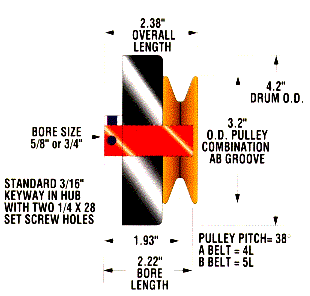
|
Max-Torque 3.20" OD
Centrifugal Pulley Clutches
|
|
PULLEY CLUTCH 3/4 BORE |
74.50 |
|
04-865 |
PULLEY CLUTCH 5/8 BORE |
74.50 |
|
Made in the USA.
Key included. Does NOT use Set Screws.
|
|
|
3.20" OD Centrifugal
Pulley Clutches 3-8hp
|
|
BELT DRIVE CLUTCH 5/8" |
38.50 |
|
|
BELT DRIVE CLUTCH 3/4" |
38.50 |
|
3.20" OD Pulley. Set Screws and Key included.
|
|
|
3/4" Bore 2" OD Pulley
Centrifugal Pulley Clutch
|
|
CLUTCH 3/4" BORE 2" PULLEY |
39.50 |
|
3/4" Bore Centrifugal Pulley Clutch, 2" Pulley.
|
|

|
Comet 1" Bore
Pulley Clutches
|
|
PULLEY CLUTCH 1" BORE S350 |
94.50 |
|
3" Outer Diameter - Built-in 1/4" Key.
Genuine Comet Clutch. Made in the USA.
|
|
|
1" Full Bore Clutch
|
|
CLUTCH 1" BORE 14T #40/41/420 |
49.95 |
|
|
CLUTCH 1" BORE 17T #35 CHAIN |
49.95 |
|
|
CLUTCH 1" BORE 15T #35 CHAIN |
49.95 |
|
1" Bore all the way through, with set screws. Go Karts with tires taller than 15" or anything larger than an 8hp engine, require a Torque Converter System that uses a belt and a chain. These clutches are great for machines with 6" rims or smaller. If you have 7" or 8" rims, you need a torque converter.
|
|
|
14 Tooth 1" Bore Clutch
Noram 1600 Series Style
|
|
CLUTCH 1" 1600 SERIES 14T |
69.95 |
|
14 Tooth Clutch for 40, 41 and 420 Chain.
1" Bore all the way through with set screws.
|
|
|
1" Bore Clutch
For 40/41/420 Chain
|
|
10 TOOTH CLUTCH 1" BORE |
39.50 |
|
For 3 to 8 Horsepower Go Karts with Rear Wheels 15" or Shorter. Requires an Engine Crankshaft with a 1/4" Keyway and a Tapped End so you can screw a bolt into the end of the crankshaft to hold the clutch on.
|
|
|
1" Bore Comet
SCS 400 Clutches
|
|
CLUTCH 1"B 12 TOOTH #35 CHAIN |
68.50 |
|
|
CLUTCH 1"B 10TOOTH #40/41/420C |
68.50 |
|
Genuine Comet Clutches for 3 to 8 Horsepower Engines and rear wheels 15" or shorter. Require a Crankshaft with a 1/4" Keyway and tapped end so you can screw a bolt into the end of the crankshaft to hold the clutch on. Made in the USA.
|
|
|
3/16" Clutch Keys
|
|
KEY 3/16" X 1/2" |
1.60 |
|
|
KEY 3/16" X 3/4" |
1.80 |
|
|
KEY 3/16" X 1-1/4" |
2.00 |
|
|
|
12" Sections of Key Stock
|
|
KEYSTOCK 3/16" X 12" |
3.80 |
|
|
KEYSTOCK 1/4" X 12" |
3.80 |
|
Key Stock - Cut as Needed.
For Crankshafts, Jackshafts, Pulleys, Axles.
|
|
|
Max-Torque Set Screw
|
|
SET SCREW 1/4-28 x 1/4 |
1.00 |
|
1/4-28 x 1/4" Set Screw for Max Torque Clutches. AS-1414F 1/4" Fine Thread Set Screw. Centrifugal Clutch Set Screw.
|
|
Clutch Maintenance
Keep Your Machine Safe
Oil the bushing that is located in the sprocket at least every two (2) hours of driving time. You'll have to oil the clutch even more often if you have small children, riding in a small area, never going fast enough to engage the clutch all the way. The clutch continues to generate heat until it engages.
Oiling the clutch is extremely important. If heat damage occurs, the clutch will never disengage and the machine will start taking off by itself as soon as you start the engine. This is very dangerous! You can see heat damage inside the clutch drum, the metal turns from black to a blue color. The clutch must be replaced if it has heat damage and won't disengage. Heat damage is never covered by warranty.
Where do you oil the clutch? Behind the snap ring, next to the sprocket teeth at the end of the clutch. There's an internal bronze bushing behind the snap ring that requires lubrication and it's up to you to put it there each time. With the engine off, squirt several drops of oil behind the snapring while the bushing is warm. You can also oil the clutch before you ride, oil the clutch and give the oil a few mintues to penetrate down into the bushing. If you don't give the oil time to get down onto the bushing, the oil will just fling off, which is the same as not oiling it at all because the oil never reaches the bushing at all. What oil should I use? A good automotive oil like 10W30 or a straight 30 weight oil is perfect. It's a good idea to oil the chain at the same time. If the chain gets kinky from lack of oil it should be replaced before it damages the clutch sprocket. A new chain is cheaper than a new clutch.
The clutch is an automatic transmission that is activated by the increased rpm of the engine. The clutch should not engage when the kart is at idle. The engine manufacturer sets the idle speed of an engine at the factory. The idle speed of the engine is normally around 1,650 rpm +/- 200 rpm. There are several things that can cause the clutch to engage at idle. Because the kart manufacturer does not start each kart after assembly, it's important that the dealer or the kart owner take a couple of minutes to read the owner's manual and review the recommended procedure when starting or servicing a new kart.
Throttle linkage can bend while riding or in transit to the dealer. It is highly recommended to always start the go kart with the rider sitting in the drivers seat with his or her foot on the brake pedal. Make sure they know which foot pedal, the one on the left, is the brake versus the gas pedal. If the driver has to start his/her own kart then place the front end of the kart against a stationary object like a tree or fence post. Once in the kart, you can roll it backwards with your hand or foot to get the kart in a position to drive forward.
During assembly at the kart factory it's possible that too much tension was placed on the throttle linkage causing the engine to idle above 2,000 rpm (the starting speed of the clutch for engagement). Think and stress safety. When you start the go-kart, be in a position where you can shut it off if the clutch wants to engage by itself. Most karts have two shut off switches on them, one on the steering column or steering wheel and the other on the engine itself. Another possibility is to pull off the spark plug wire, which might give you a slight shock.
A Tachometer (available on our Tools Page) can be used on the engine to verify just where the engine idle speed is set. You can't verify the correct rpm by listening to the engine and concluding it is too high or too low.
Habits That Can Ruin A Clutch
Driving too slowly: A clutch starts to engage around 2,000 rpm and will lock up around 2,600 rpm. Driving at full throttle gives the clutch a chance to cool down. Full throttle locks the shoes in the clutch against the drum. When the clutch is not locked up, the shoes slip against the drum causing tremendous heat which dries up the lubrication in the oil impregnated bushing. The tremendous amount of heat generated can also anneal the spring which is the heart of the clutch. If the shoes turn purple from excessive heat more than likely the clutch is ruined and the spring no longer has the ability to pull back the shoes at idle.
Short stop and go driving: The longer you drive at full throttle the better off it is for the clutch, because it gives it a chance to cool off before the next engagement.
Driving with the foot on the brake: This is a problem with new drivers that are unsure of themselves. When riding a go kart for the first time, try to find an open area that has no obstacles that you have to maneuver around until you get used to the brake and gas pedals. The driver must first be able to build up his or her confidence on the kart before putting obstacles in their path. A small back yard is not a good place to learn to drive a go kart. In my opinion, a minimum of three fourths of an acre is the amount of yard needed for a go kart. Teach your child to drive with one foot on the pedal, be it the brake or the gas but not to press on both pedals at the same time. You either want to go or to stop but you cannot do them both at the same time.
Changing the size of the tires: Putting on tires that are larger than what came with the kart will result in clutch problems. Tires exceeding 13 inches in diameter stress out a clutch if the kart is not properly geared for the larger tires. If you are driving on smooth flat terrain than you may be able to get by with 15 inch tires but once you get on hilly terrain, deep grass, then you are putting additional strain on the clutch, which will cause premature wear. Big tires look cool on a go kart but you create your own problem changing to bigger tires when the clutch isn't designed to handle them.
Weight: A centrifugal clutch is designed to be able to move a certain amount of weight. Once the weight limit is exceeded, then the life of the clutch will be shortened. A good rule of thumb is the kart and driver (and passenger when it is a two seat kart) should not exceed 400 pounds. The kart weighs around 150 pounds add to this the driver (and passenger weight, if it is a two seater kart). If you know ahead of time that you will exceed the 400 pounds then buy a torque converter go kart and avoid the problems of burning up the clutch asking it to do more than it was designed for.
Gear ratio: The sprocket on the engine and the one on the rear axle should have a ratio close to 1:6. This means for every tooth on the clutch there are six teeth on the rear sprocket. So if you count 10 teeth on the clutch there should be 60 teeth on the rear sprocket. (12 teeth on the clutch means a 72 teeth rear sprocket). A torque converter has a variable speed system between the driver and the driven pulleys so it can improve upon this ratio, which gives the torque converter an advantage over a straight clutch system. It improves the ratio by approximately 3:1 and can turn larger tires and drive at slower speeds without doing any damage to the clutch system. A torque converter is a more expensive system initially but it will last longer and is more trouble free when maintained.
Restrictions: Don't try and reduce a go kart speed by limiting the travel of the gas pedal or by putting a restrictor in the carburetor to limit full rpm. Either of these methods will result in the clutch slipping, which is self destructive. A clutch needs full rpm to lock up as quickly as possible to be able to start to cool down. To slow down a go kart you would need to purchase a gear reduction unit, which is like training wheels on a go kart until the driver gets use to how the go kart handles. A gear reduction unit can reduce the speed of the go kart in half.
Keep the clutch and chain lubed ... Oiling a stiff, dried out chain is a waste of time.
Don't put oil inside the clutch holes: The holes on the drum are to let the hot air out of the clutch. DO NOT SQUIRT OIL IN THESE HOLES. When oil gets in the drum portion of the clutch it will cause excessive slippage, which means undue heat will be generated.
If your kart has a grease fitting in the crankshaft for lubrication then a shot of grease once a month should be sufficient lubrication. The grease is coming from the inside of the sprocket outward, which is a better way to lubricate the clutch. The keyway in the crankshaft acts as a reservoir for the grease, which cuts down on the frequency needed for maintenance compared to oiling the snap ring area. The chain still needs to be oiled frequently to keep it from kinking up. There are some excellent chain sprays available that are waxy and will not let sand and dirt adhere to them. Dirt and sand will wear the chain as well as the sprockets.
All chains stretch over time. When the chain starts falling off the sprocket then it is time to move the engine forward or backward to take up the slack in the stretched chain. There are four bolts that hold the engine on the motor mount plate. Take an open end wrench and a socket wrench (most likely a 9/16") and loosen the four bolts, pull back the engine until you take up the slop in the chain. Tighten the bolts back again but make sure the two sprockets are perfectly aligned with each other. You don't want the sprockets out of alignment because this will cause the chain to come off or wear the sprockets unevenly. Leave about half an inch of play between the top of the chain and the bottom, don't pull the engine back where the chain is a tight as you can get it. A tight chain can cause the kart to move in neutral with no one in the drivers seat. A tight chain puts friction on the bushing or roller bearing, which could cause it to engage when the engine is idling. A tight chain also wears out the sprocket teeth really fast.
Teach your child how to do the maintenance on the kart and accept responsibility for its upkeep. Every second tank of gas in the kart is about the interval for oiling the chain and the bushing.
Clutch warranty: How long will the clutch last? If it's installed on the engine crankshaft properly, without using the "magic hammer" to pound it on the shaft, using the right length key (half inch) and observing all the hints that are pointed out here, a clutch should last several years. But, if it's improperly installed, driven in abusive conditions (sand, steep terrain, excessive weight in the kart or rear tires taller than 15 inches), the clutch might only last 20 minutes. If the shoes are blued don't bother sending the clutch back for a warranty replacement. Heat damage is not a factory defect, it wasn't sold with blued shoes. If the clutch is abused, the tell tale signs are easy to spot. Go Karts with rear tires taller than 15 inches or an engine larger than 8 horsepower require a torque converter. If your kart has rear rims larger than 6 inches you'll have to install a Torque Converter that uses a belt and a chain. The last number of the tire size is the rim size.
Hints that Help by Max-Torque! There are no rollers in 219 or #35 chains. Roller chain starts at 1/2" pitch chains which are: #40, #41, #420 and #428 and larger chains. The bigger the gap between the connecting roller link plate and the fixed roller link on the #35 chain, the easier it is to get lubrication in where it is needed. Chain binds on the inside of the roller NOT on the outside surface so spraying lube on the outside of the chain doesn’t accomplish much. Getting the lubrication between the pin and the plates is the secret on how to correctly lube the chain. How, when and what you lubricate with is the purpose of this article.
The inside of the clutch, when the engine is idling, acts like a fan drawing air around the drum to keep the shoes cool. Any excess oil on the chain is going to be sucked into the clutch. It will get on the shoes and in the drum and will have to be burnt off before the clutch will work consistently again. Check your blow-by line off the engine to make sure you have a good seal. It is very important to have the line hooked up properly because of where that oil can go and the problems it can cause. Using your blow-by line to lube your chain is not a very good idea and will cause more problems than it is worth.
The oil additives that can give you problems if they happen to get on your disc or in the drum of your clutch are: Slick 50, Dynamite, Energy Release and any oil that has Teflon or Silicone as one of the ingredients. Any oil that says it is anti-friction be very cautious what you use it on because Teflon or silicone are clutch killers. These are excellent internal engine oil ingredients but will give you fits if they get inside the clutch or on the brake disc. They do just what they are intended to do which is to prevent friction -- steel to steel contact. On a clutch and a brake system, you need friction to have them work properly. The bad news is these lubricants impregnate the steel. Sanding or cleaning with a solvent, brake cleaner or gasoline will not help. Once it is in the metal, it is in there forever because the heat will bring these lubricants back to the surface.
Now back to the chain and what to do to get it race ready. We only use a continuous link chain because master links always break at the worst time. Any chain manufacturer will tell you the weakest link on the chain is the master link. To oil our chain, we take it off and clean it with WD-40 and an air hose. I don’t like to use brake cleaner, solvent or gasoline because these will contaminate my oil bath. We then put our chain as well as our sprockets in a coffee can with 2" of 30 weight petroleum base automotive oil AND a 1/2 of a cube of paraffin wax that you can buy at the grocery store. There will be three cubes in the box, only use 1/2 of one cube.
The coffee can will be placed in a frying pan with a 1/2” of water in the bottom of the frying pan which acts then like a double boiler so we do not have direct heat on the coffee can. Now place it on the stove with the heat turned up to medium (180 F degrees ( 64.5C) for 30 to 45 minutes). When the wax melts into the oil you are done and you can now take it off the stove and hang the chain and sprockets over the can to let the excess drip back into the can to reuse many times. Do not bring the oil to a boil because we don’t want to break down the oil, we just want it hot to get the maximum penetration. The oilite bushing manufactures heat their oil up in a closed system, vacuum out the air that draws the oil into the pores of the bushing. In a new oilite bushing, 15% of the weight of the bushing is the oil that is impregnated into the oilite bushing using a vacuum system. The heat will cause the air to come to the surface of the oil. The void around the pin and roller link will be replaced by oil. The paraffin wax when it melts will act like a seal to keep the oil around the pin in the chain and seal the oil into the bushing. Take the chain out of the hot oil after it has soaked for at least 30 minutes and let the oil and wax drip back into the can to reuse the following week repeating the same process. When it has cooled down store the chain and sprockets away in a plastic bag. There is no need to wipe them off just mount the chain back on the kart when you are at the track next week. Put the sprocket back in the drum and you have enough lube in the chain or on the sprocket to last you a weekend of racing.
The oilite bushing used in a clutch contains sufficient oil to self-lube the sleeve upon which it is rotating for many races before it needs to be replenished. The oil comes out in very minute amounts and gets on the inside of the clutch drum, that is why it is a good idea to wipe out the inside of the drum before your final race of the day. Maintenance is very important on all clutches and preventive maintenance will give you consistency in a clutch. As the oil builds up on the shoes of the clutch and in the drum you start getting excessive slippage so now it is time to sand the shoes and the inside of the drum with some 80 grit sandpaper or emery cloth. After you sand the shoes and sand the inside of the drum wipe them off with a clean rag or blow them off with some air. I would only recommend brake cleaner on a steel shoe clutch never on a clutch that has phenolic resin material. Don’t spray it inside a clutch drum unless you have removed the sprocket. The reason they call it BRAKE CLEANER is that is what you should use it on. It is not really a clutch cleaner but if you use it to clean the clutch make sure you avoid getting any near the oilite bushing or roller bearing. You will contaminate the oilite bushing and no lubricant will stay for very long because the brake cleaner is breaking it down too fast. The other thing I observe when walking through the pits and watching crews clean a clutch, if a little spray is good, a ½ of can must be better yet. They end up spraying the inside of the drum containing the sprocket. If it has a bushing, the brake cleaner will dry out what lubrication is left in the bushing, so when it is put back together, the clutch wants to engage at idle on the line waiting to go out on the track. The safest thing to clean a clutch with is a paper towel or a clean rag, some WD-40 and an air hose. Wipe out the inside of the bushing with a paper towel or pull a rag through the bore, put some petroleum base oil on your finger and work it into the bushing. Follow these simple little tricks and a bushing clutch will never give you a problem. Remember a bushing or roller bearing are only functional when you are at idle, if the kart is moving the clutch is acting as ONE piece of steel.



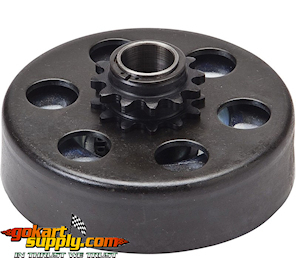
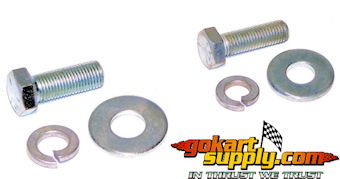

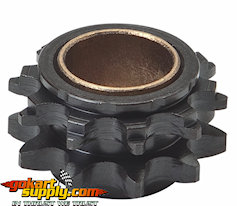
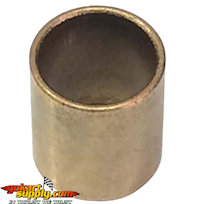

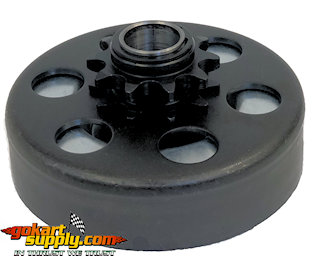

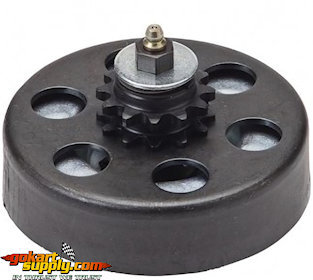

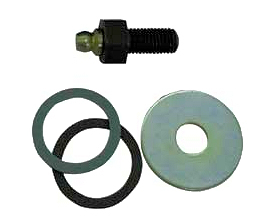



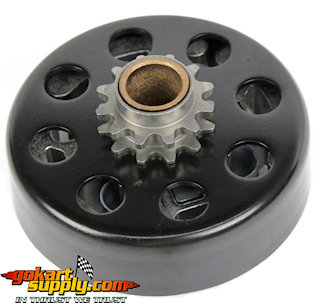

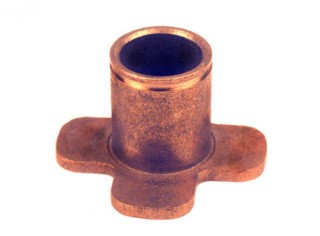

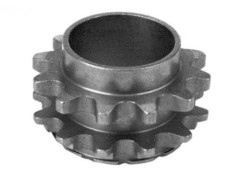
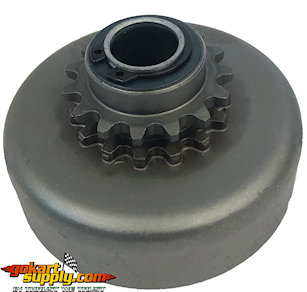
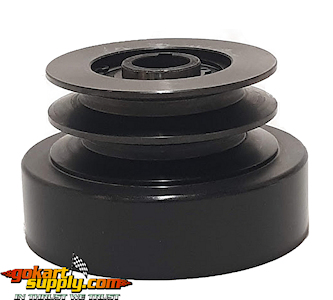


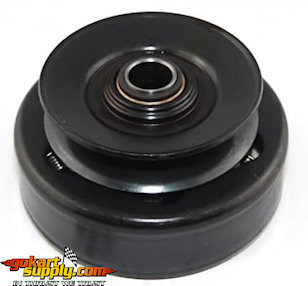

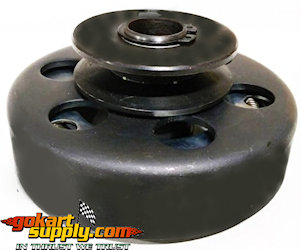

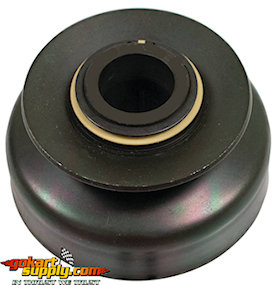
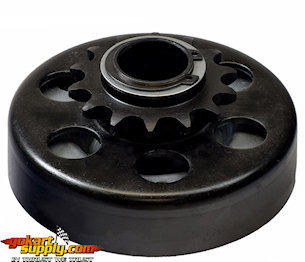
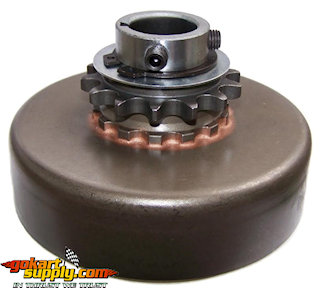
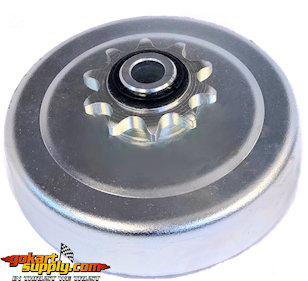
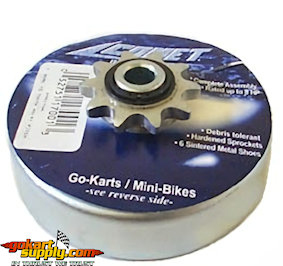



![]()